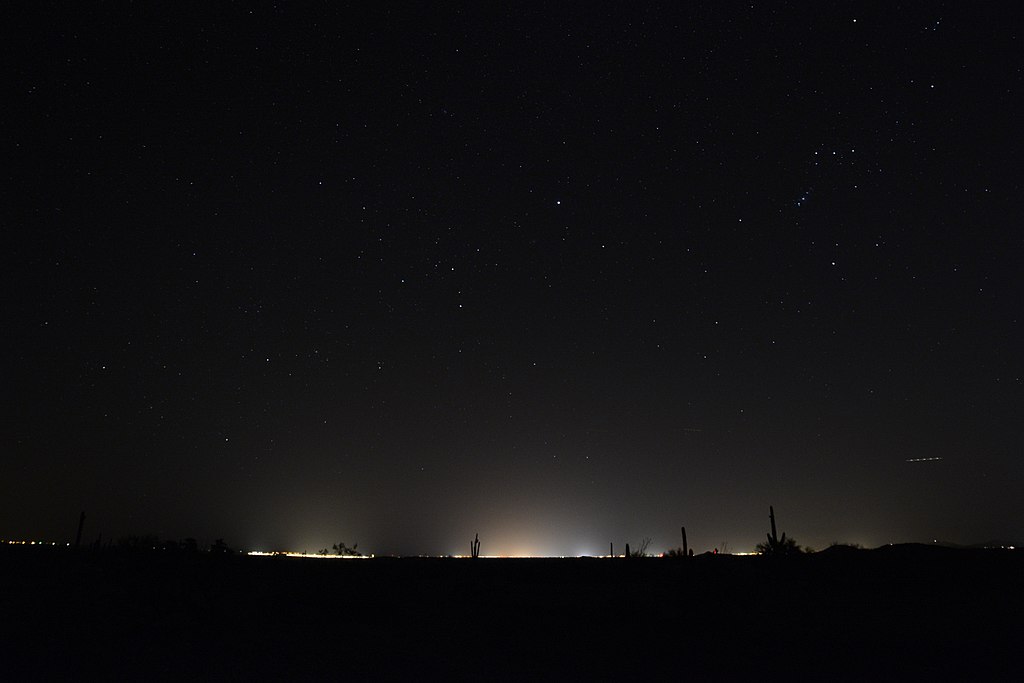For those of us who enjoy getting out and away, the natural night sky filled with only the illumination of celestial bodies brings both peace and inspiration. But light pollution—the effects of artificial lights overpowering the natural darkness—is becoming more and more of a rising issue in our world.

The Milky Way in the night sky at Black Rock Desert, NV (Photo by Steve Jurvetson, Wikipedia)
The artificial lighting of the night sky is being studied and evidence suggests that negative effects are more than a mere annoyance.
Light pollution affects natural ecosystems including nocturnal animals, bird migration patterns, sea turtle hatchlings being able to find the ocean, insect populations, and even human health. Disturbances to our natural circadian rhythm and melatonin production is suppressed by exposure to artificial light.

City lights from Phoenix as seen from 55 miles away. (Photo by Gppercy, Wikipedia)
Gppercy, CC BY-SA 4.0, via Wikimedia Commons
The International Dark Sky Association, based out of Tucson, AZ, maintains a list of Dark Sky Places. The International Dark Sky Places Program encourages the protection of dark skies and responsible lighting. Becoming a designated Dark Sky place involves an application process and specific requirements.
There are 26 National Parks that have earned designations as International Dark Sky Parks, including Arches National Park, Utah, Capulin Volcano National Monument, NM, Craters of the Moon National Monument, ID, Grand Canyon National Park, AZ, Death Valley National Park, CA, and Great Sand Dunes National Park, CO.
Most recently, El Morro National Monument in western New Mexico was granted designation as an International Dark Sky Park. The process took about a year, and included measuring the quality of the night sky, and identifying areas where light pollution can be reduced. El Morro is a historic waterhole at the base of a sandstone bluff that has been used as a campsite for hundreds of years by Puebloans, Spanish, and American travelers.

The majestic Cliff Palace at Mesa Verde (Photo by Lorax, Wikipedia)
Mesa Verde National Park in southwest Colorado is bidding to be designated a Dark Sky Park in 2020. The Mesa Verde area was populated by ancestral Puebloans from about 600-1300 AD. The picturesque cliff dwellings and archaeological sites left behind are a legacy to the ancient people who lived for centuries under dark night skies.
Jackson Lake State Park in northeastern Colorado is also bidding to become a designated Dark Sky Place. Jackson Lake is a favorite for boating, fishing, and birding. Part of their application includes changing all the lights inside and outside buildings to be dark-sky friendly.
Viewing an unspoiled night sky inspires wonder of the universe and allows us to feel a part of a much larger universe of mystery and natural wonder. Finding a campsite away from city lights where you can sit and view the Milky Way is a treasure that we may take for granted. The next time you have the opportunity to sit and stargaze, take a moment to appreciate the night sky and the darkened views it offers.
See also:
- The Ultimate Stargazing Trip From Big Bend National Park To Yellowstone
- 10 Of The Best Places In The U.S. To Go Stargazing

First a joke…. “Is it time to boycott light bulbs?”
Seriously, there there is nothing more majestic than a desert night sky.
Steaming ISE (Independent Steaming Exercises) on a Navy ship in the Pacific Ocean or Caribbean Sea presented unequalled views of limitless stars, planets, galaxies and other cosmic objects. Nothing like it. Something to be pursued and treasured!
I couldn’t agree more with you about light pollution. My wife and I did the Havasupai Hike in the Grand Canyon this past September and I can’t remember a darker night sky. She said it was similar to when she was on safari in South Africa. We also just passed El Morro but didn’t have time to stop. Have you been there?
Surprised that Great Basin National Park was not mentioned. I believe it has the darkest sky in the contiguous US, at least that is what we were told when visiting there about 8 years ago. Camping at 10,000 feet you could see galaxies with the naked eye on moonless nights. Just need to take some time to acclimate to the altitude.
My wife and I have long been proponents of Dark Skies. The problem is that many RVers seem not to be. So many leave their awning lights, their step lights, the lights in the front of their 5th wheel, on all night. It’s as if they are afraid of the dark.
Please…..turn off your outside lights when you retire!
The night sky over our central Colorado retirement home was amazing. Nearly 4000′ above and a hundred miles away from Denver, you could see roughly the same number of stars.with the naked eye as with binoculars in the city.
I’m totally on board with the death penalty being imposed on all the people who feel the need to light up every dark sky they encounter.
Being an amateur astronomer and having a backyard observatory, I had neighbors who put up a night light and ruin my site. I tried to negotiate with them but they thought there was nothing I could do about it. I took them to court and won a judgement where they had to take down the light or put a switch on it for me and only use lights coming and going to their residence. They were warned not to interfere with my observing. Lots of money spent over something that could have been settled by compromise.
Second joke… with all of the light pollution happening, how are to see the approaching Mother ship?